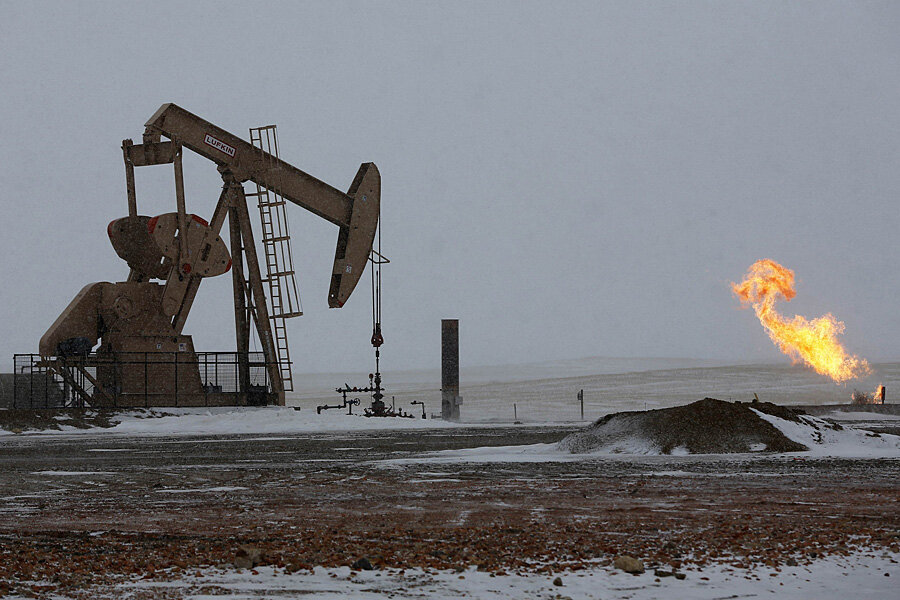North Dakota oil output hits 1 million barrels per day
Loading...
| Williston, N.D.
North Dakota has joined the ranks of the few places in the world that produce more than a million barrels of oil per day, due in large part to the rich Bakken shale formation in the western part of the state.
The April figures released Tuesday by the state's Department of Mineral Resources showed the record tally. North Dakota had flirted with the million-barrel-per-day mark for months, but the harsh winter slowed the pace. In March, production had hit 977,000 barrels per day.
North Dakota's oil fields now represent more than 12 percent of all U.S. oil production, and more than 1 percent of global production — a situation unfathomable just a decade ago, when technology hadn't yet caught up to the challenge of extracting oil from the shale. Since then, the oil boom and the jobs it brings have transformed North Dakota, now home to the nation's fastest-growing cities and its lowest unemployment rate.
"Reaching the 1 million barrel a day mark is a tremendous and timely milestone for the petroleum industry and our state, but it is also a tremendous milestone for our nation," U.S. Sen. John Hoeven, a Republican, said in a statement, citing the need for the United States to build its domestic energy resources.
North Dakota joins Texas, Alaska, California and Louisiana as the only states ever to produce more than a million barrels per day. Of those, Texas is the only other state still producing above that level.
"Until April, only Texas, one Canadian province and 19 countries were producing 1 million barrels per day, putting North Dakotaamong the top oil producers in the entire world," said Ron Ness, president of the North Dakota Petroleum Council, an oil lobbying group.
The state's production is still dwarfed by behemoths such as Saudi Arabia, the world's largest producer with nearly 10 million barrels of oil per day.
But North Dakota's ascent has been rapid. Whereas eastern Saudi Arabia's Ghawar field, the top-producing oil field in the world with 5 million barrels a day, has been operational since 1951, North Dakota's oil fields have surged from producing 80,000 to 90,000 barrels per day a decade ago.
The Bakken and the Three Forks formation below it, which also stretch into Montana and Canada's Saskatchewan province, account for the vast majority of North Dakota's oil production.
Oil was first struck in western North Dakota in 1951 near the town of Tioga, but for decades, the area confounded oil producers, giving up trickles while promising potentially enormous gains. After a smaller oil boom went bust in the 1980s, many gave up on the state as a big oil producer. At one point in 1999, no drilling rigs remained in North Dakota.
But just over half a decade ago, advances in directional drilling and hydraulic fracturing finally unlocked the oil packed into the Bakken shale formation.
Now "North Dakota could be an OPEC country of its own in terms of production — it's essentially the production of Ecuador," said James Fallon, director of downstream energy at global information firm IHS.
Together with Texas' Permian Basin and Eagle Ford oil plays, North Dakota's production has played a pivotal role in turning U.S. production around in the past few years after more than 30 years of decline and cutting down on petroleum imports he added. Fallon said it is likely that because of these oil plays, the U.S. will surpass its 1970 production high of 9.64 million barrels per day within the next year and a half.
Lynn Helms, director of the Department of Mineral Resources' Oil and Gas Division, said he expects North Dakota production to grow to 1.5 million barrels per day by 2017 before plateauing.
Besides the influx of jobs, high salaries have skewed the economy of the oil patch, with one-bedroom apartments renting for $2,000 a month. Police departments, health care services, schools, roads and other public services and infrastructure have struggled to keep up with the growth in the western part of the state.
Despite the trials that oil development has brought, the boom has largely been welcomed at a time when jobs can be hard to come by elsewhere in the U.S.







